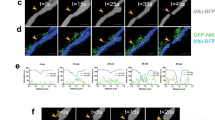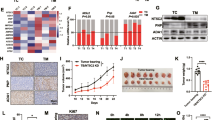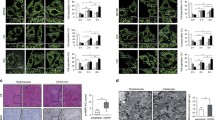Abstract
Although the Warburg effect is a dominant metabolic phenotype observed in cancers, the metabolic changes and adaptation occurring in tumors have been demonstrated to extend beyond the Warburg effect and thus considered a secondary effect to the transformation process of carcinogenesis, including nutritional deficiencies. However, the role of nutritional deficiencies in this metabolic reprogramming (e. g., oxidative phosphorylation (OXPHOS)/glycolysis interconversion) is not completely known yet. Here, we showed that under regular culture condition, the proliferation of U251 cells, but not other tumor cell lines, preferentially performed the Warburg effect and was remarkably inhibited by oxamic acid which can inhibit the activity of lactate dehydrogenase (LDH); whereas under serum starvation, glycolysis was depressed, tricarboxylic acid cycle (TCA) was enhanced, and the activity of OXPHOS was reinforced to maintain cellular ATP content in a high level, but interestingly, we observed a decreased expression of reactive oxygen species (ROS). Moreover, the upregulated activity of mitochondrial complex I was confirmed by Western blots and showed that the mitochondrial-related protein, NDUFA9, NDUFB8, ND1, and VDAC1 were remarkably increased after serum starved. Mechanistically, nutritional deficiencies could reduce hypoxia-inducible factor α (HIF-1α) protein expression to increase C-MYC protein level, which in turn increased nuclear respiratory factor 1 (NRF1) and mitochondrial transcription factor A (TFAM) transcription to enhance the activity of OXPHOS, suggesting that metabolic reprogramming by the changes of microenvironment during the carcinogenesis can provide some novel therapeutic clues to traditional cancer treatments.







Similar content being viewed by others
References
Moreno-Sanchez R, Marin-Hernandez A, Saavedra E, Pardo JP, Ralph SJ, Rodriguez-Enriquez S. Who controls the ATP supply in cancer cells? Biochemistry lessons to understand cancer energy metabolism. Int J Biochem Cell Biol. 2014;50:10–23. doi:10.1016/j.biocel.2014.01.025.
Bustamante E, Morris HP, Pedersen PL. Energy metabolism of tumor cells. Requirement for a form of hexokinase with a propensity for mitochondrial binding. J Biol Chem. 1981;256(16):8699–704.
Diaz-Ruiz R, Uribe-Carvajal S, Devin A, Rigoulet M. Tumor cell energy metabolism and its common features with yeast metabolism. Biochim Biophys Acta. 2009;1796(2):252–65. doi:10.1016/j.bbcan.2009.07.003.
Warburg O. On the origin of cancer cells. Science. 1956;123(3191):309–14.
Nakajima EC, Van Houten B. Metabolic symbiosis in cancer: refocusing the Warburg lens. Mol Carcinog. 2013;52(5):329–37. doi:10.1002/mc.21863.
Solaini G, Sgarbi G, Baracca A. Oxidative phosphorylation in cancer cells. Biochim Biophys Acta. 2011;1807(6):534–42. doi:10.1016/j.bbabio.2010.09.003.
Bonuccelli G, Tsirigos A, Whitaker-Menezes D, Pavlides S, Pestell RG, Chiavarina B, et al. Ketones and lactate “fuel” tumor growth and metastasis: evidence that epithelial cancer cells use oxidative mitochondrial metabolism. Cell Cycle. 2010;9(17):3506–14.
Bashan N, Burdett E, Hundal HS, Klip A. Regulation of glucose transport and GLUT1 glucose transporter expression by O2 in muscle cells in culture. Am J Physiol. 1992;262(3 Pt 1):C682–90.
Johnson MA, Vidoni S, Durigon R, Pearce SF, Rorbach J, He J, et al. Amino acid starvation has opposite effects on mitochondrial and cytosolic protein synthesis. PLoS One. 2014;9(4):e93597. doi:10.1371/journal.pone.0093597.
Xie J, Wu H, Dai C, Pan Q, Ding Z, Hu D, et al. Beyond Warburg effect—dual metabolic nature of cancer cells. Sci Rep. 2014;4:4927. doi:10.1038/srep04927.
Chen M, Huang J, Yang X, Liu B, Zhang W, Huang L, et al. Serum starvation induced cell cycle synchronization facilitates human somatic cells reprogramming. PLoS One. 2012;7(4):e28203. doi:10.1371/journal.pone.0028203.
Cooper S. Reappraisal of serum starvation, the restriction point, G0, and G1 phase arrest points. FASEB J. 2003;17(3):333–40. doi:10.1096/fj.02-0352rev.
Signorile A, Micelli L, De Rasmo D, Santeramo A, Papa F, Ficarella R, et al. Regulation of the biogenesis of OXPHOS complexes in cell transition from replicating to quiescent state: involvement of PKA and effect of hydroxytyrosol. Biochim Biophys Acta. 2014;1843(4):675–84. doi:10.1016/j.bbamcr.2013.12.017.
Kanai M, Iba S, Okada R, Tashiro E, Imoto M. Oligomycin induced the proteasomal degradation of cyclin D1 protein. J Antibiot (Tokyo). 2009;62(8):425–9. doi:10.1038/ja.2009.47.
Rodriguez-Paez L, Chena-Taboada MA, Cabrera-Hernandez A, Cordero-Martinez J, Wong C. Oxamic acid analogues as LDH-C4-specific competitive inhibitors. J Enzyme Inhib Med Chem. 2011;26(4):579–86. doi:10.3109/14756366.2011.566221.
Sweet S, Singh G. Accumulation of human promyelocytic leukemic (HL-60) cells at two energetic cell cycle checkpoints. Cancer Res. 1995;55(22):5164–7.
Kurbacher CM, Cree IA. Chemosensitivity testing using microplate adenosine triphosphate-based luminescence measurements. Methods Mol Med. 2005;110:101–20. doi:10.1385/1-59259-869-2:101.
Vives-Bauza C, Yang L, Manfredi G. Assay of mitochondrial ATP synthesis in animal cells and tissues. Methods Cell Biol. 2007;80:155–71. doi:10.1016/s0091-679x(06)80007-5.
Yu M, Dai J, Huang W, Jiao Y, Liu L, Wu M, et al. hMTERF4 knockdown in HeLa cells results in sub-G1 cell accumulation and cell death. Acta Biochim Biophys Sin (Shanghai). 2011;43(5):372–9. doi:10.1093/abbs/gmr020.
Zhang E, Li X, Zhang S, Chen L, Zheng X. Cell cycle synchronization of embryonic stem cells: effect of serum deprivation on the differentiation of embryonic bodies in vitro. Biochem Biophys Res Commun. 2005;333(4):1171–7. doi:10.1016/j.bbrc.2005.05.200.
Hsiao YP, Lai WW, Wu SB, Tsai CH, Tang SC, Chung JG, et al. Triggering apoptotic death of human epidermal keratinocytes by malic acid: involvement of endoplasmic reticulum stress- and mitochondria-dependent signaling pathways. Toxins (Basel). 2015;7(1):81–96. doi:10.3390/toxins7010081.
Nazmara Z, Salehnia M, HosseinKhani S. Mitochondrial distribution and ATP content of vitrified, in vitro matured mouse oocytes. Avicenna J Med Biotechnol. 2014;6(4):210–7.
Xiong W, Huang W, Jiao Y, Ma J, Yu M, Ma M, et al. Production, purification and characterization of mouse monoclonal antibodies against human mitochondrial transcription termination factor 2 (MTERF2). Protein Expr Purif. 2012;82(1):11–9. doi:10.1016/j.pep.2011.10.012.
Ratcliffe PJ. From erythropoietin to oxygen: hypoxia-inducible factor hydroxylases and the hypoxia signal pathway. Blood Purif. 2002;20(5):445–50.
Semenza GL, Rue EA, Iyer NV, Pang MG, Kearns WG. Assignment of the hypoxia-inducible factor 1alpha gene to a region of conserved synteny on mouse chromosome 12 and human chromosome 14q. Genomics. 1996;34(3):437–9. doi:10.1006/geno.1996.0311.
He M, Wang QY, Yin QQ, Tang J, Lu Y, Zhou CX, et al. HIF-1alpha downregulates miR-17/20a directly targeting p21 and STAT3: a role in myeloid leukemic cell differentiation. Cell Death Differ. 2013;20(3):408–18. doi:10.1038/cdd.2012.130.
Zhang H, Gao P, Fukuda R, Kumar G, Krishnamachary B, Zeller KI, et al. HIF-1 inhibits mitochondrial biogenesis and cellular respiration in VHL-deficient renal cell carcinoma by repression of C-MYC activity. Cancer Cell. 2007;11(5):407–20. doi:10.1016/j.ccr.2007.04.001.
Kim J, Lee JH, Iyer VR. Global identification of Myc target genes reveals its direct role in mitochondrial biogenesis and its E-box usage in vivo. PLoS One. 2008;3(3):e1798. doi:10.1371/journal.pone.0001798.
Li F, Wang Y, Zeller KI, Potter JJ, Wonsey DR, O’Donnell KA, et al. Myc stimulates nuclearly encoded mitochondrial genes and mitochondrial biogenesis. Mol Cell Biol. 2005;25(14):6225–34. doi:10.1128/mcb.25.14.6225-6234.2005.
Yu J, Wang Q, Chen N, Sun Y, Wang X, Wu L, et al. Mitochondrial transcription factor A regulated ionizing radiation-induced mitochondrial biogenesis in human lung adenocarcinoma A549 cells. J Radiat Res. 2013;54(6):998–1004. doi:10.1093/jrr/rrt046.
DeBerardinis RJ, Lum JJ, Hatzivassiliou G, Thompson CB. The biology of cancer: metabolic reprogramming fuels cell growth and proliferation. Cell Metab. 2008;7(1):11–20. doi:10.1016/j.cmet.2007.10.002.
Vander Heiden MG, Cantley LC, Thompson CB. Understanding the Warburg effect: the metabolic requirements of cell proliferation. Science. 2009;324(5930):1029–33. doi:10.1126/science.1160809.
Hanahan D, Weinberg RA. Hallmarks of cancer: the next generation. Cell. 2011;144(5):646–74. doi:10.1016/j.cell.2011.02.013.
Chen G, Dai J, Tan S, Meng S, Liu Z, Li M, et al. MTERF1 regulates the oxidative phosphorylation activity and cell proliferation in HeLa cells. Acta Biochim Biophys Sin (Shanghai). 2014;46(6):512–21. doi:10.1093/abbs/gmu029.
Wu H, Ding Z, Hu D, Sun F, Dai C, Xie J, et al. Central role of lactic acidosis in cancer cell resistance to glucose deprivation-induced cell death. J Pathol. 2012;227(2):189–99. doi:10.1002/path.3978.
Kianercy A, Veltri R, Pienta KJ. Critical transitions in a game theoretic model of tumour metabolism. Interface Focus. 2014;4(4):20140014. doi:10.1098/rsfs.2014.0014.
Kennedy KM, Dewhirst MW. Tumor metabolism of lactate: the influence and therapeutic potential for MCT and CD147 regulation. Future Oncol. 2010;6(1):127–48. doi:10.2217/fon.09.145.
Acknowledgments
We would like to thank all the members of our laboratory for the encouragement and help in this study. This work was financially supported by the National Natural Science Foundation of China (no. 31260276, no. 31160237, and no. 81271330), the talent program of Yunnan Province (no. W8110305), and the Yunnan Province Science and Technology Innovation Team (no. 2011CI123)
Authors’ contributions
ZJL, YS, and MY designed the experiments with valuable help from QHC, MZL, HUH and ZJL performed and analyzed data with valuable help from ST and LL, and ZJL wrote the manuscript. ZJL and MY oversaw the overall project.
Author information
Authors and Affiliations
Corresponding author
Ethics declarations
Conflicts of interest
None
Rights and permissions
About this article
Cite this article
Liu, Z., Sun, Y., Tan, S. et al. Nutrient deprivation-related OXPHOS/glycolysis interconversion via HIF-1α/C-MYC pathway in U251 cells. Tumor Biol. 37, 6661–6671 (2016). https://doi.org/10.1007/s13277-015-4479-7
Received:
Accepted:
Published:
Issue Date:
DOI: https://doi.org/10.1007/s13277-015-4479-7




